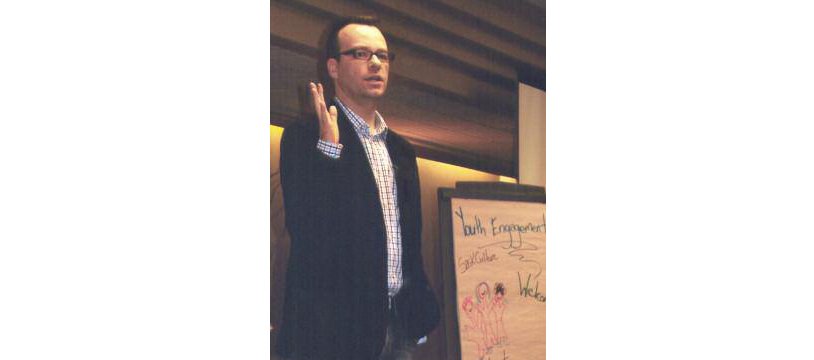
Connecting culture through social media
At the SaskCulture Gathering in 2011, social media expert Darren Barefoot began by clarifying the difference between “digital immigrants”, those who are just learning to use social media (usually 32 years plus), and “digital natives” those that have grown up in an online world. According to Barefoot, social media might have created the greatest age divisiveness since rock ‘n roll.
However, Barefoot feels that organizations can take positive steps in building social media into their operations and daily routines. Barefoot, who lives in Vancouver, is a co-founder of Capulet Communications, a writer, marketer and technologist, who regularly speaks about social media and has co-authored, along with Julie Szabo, the book Friends With Benefits: a Social Media Marketing Handbook (2009). In his presentation, he shared several key lessons for the digital immigrants interested in embarking on social media opportunities. “Teach your staff – digital natives and immigrants alike – about privacy online,” Barefoot says. Privacy concerns are usually divided by age, he says, generally the older someone is, the more concerned they might be. When in reality, he explains, privacy is less of an issue than one may think.
“Deliver value,” he says. There is so much online competition for a user’s attention. He says, those using social media are looking for entertainment, advice, education, information and to be inspired. In addition, he says organizations should be aware of what strategies their competition might be undertaking.
Social media continues to grow at a rapid pace. Today, there are over 800 million Facebook users, and over 200 million users on Twitter. Users continue to create new options to meet every need. For example, LinkedIn offers a professional social network opportunity and FourSquare, which uses a global positioning system on a mobile device, helps build what is known as “social swarming tool” – where one can track down businesses, friends and special deals by location. mySpace, which was one of the earliest out the gate, is still in use. And, Google+, which has arrived late in the game, is ready to tackle its competition with a user-friendly format.
Studies show that North Americans spend on average 55 hours a week looking at a screen, whether it’s a television, mobile device or computer.
Barefoot notes that the increased use of mobile devices needs serious consideration. His statistics say that over one-third of Facebook users, check Facebook from a mobile device, as do over half of Twitter users. Over 33 per cent of brand searches are on mobile phones or tablets. “Consider how your web site looks on a mobile device,” he adds. And, the increased mobile use has lead to an increased interest in mobile applications, known as Apps. However, he points out that more than half of online users that still come through a browser.
Barefoot encouraged organizations to think, or rethink, about their online audiences. He shared a concept from Rick Warren’s book, “A Purpose-driven Church” (1995), that involves identifying who is in an organization’s crowd, its community, its congregation, its committed and its core. Each of these groups requires different tactics to move them closer to an organization’s core.
He suggested many different engagement tools designed to inspire user contributions, such as reviews, ratings, online polls, storytelling, contests, maps and the use of Quick Response (QR) codes on print promotions. Whatever the tool, he recommended following Seth Godin’s advice, from his book The Purple Cow (2010), and “aim for remarkable”.
He urged those interested to create a strategy around social media that included identifying key objectives that would help determine which social media tool would be the best driver for their organization. And, once social media programs are in place, Barefoot recommends continued measurement of its use, though readily available tools such as Google Analytics. Most delegates were intrigued and recognized the needs to investigate further. “Its early days for the social media technology,” says Barefoot. “But it’s here to stay.”

